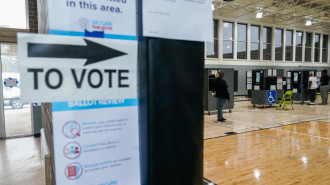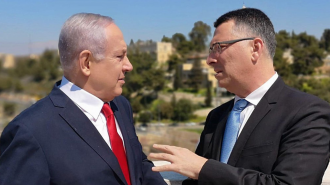Iraq's Najaf cemetery expands to accommodate more Mosul casualties
One of the world's largest cemeteries in Iraq's holy Shia city of Najaf is expanding as the fight to free Mosul from Islamic State group rule escalates.
A new plot of land has recently been allocated at Wadi al-Salam - Valley of Peace - to accommodate the rise in casualties from the operation, now in its second month.
Gravediggers say they are burying an average of 20 Shia militiamen everyday, and with the Iraqi government not publicising the number of fallen, the figures offer one indicator of the battlefield losses from the Shia-dominated security forces.
"Whenever there is a big offensive, the number increases to 40 or 50," gravedigger Shakir Mahmoud told AP.
The 10 square kilometre cemetery is already home to millions of graves of Muslims from Iraq and other nations because of its proximity to the shrine of Imam Ali, the much revered 7th century figure behind the inspiration for Shia Islam.
The Najaf cemetery's rapid expansion is testament to the scale of violence in Iraq over the decades, from the 1980 to 1988 war with Iran, to the 13 years of bloodshed since the US-led invasion in 2003.
Haider Moussa, 23, was among the tens of thousands of Shias who answered the call to arms by Iraq's top Shia clerics in the wake of the IS sweep across northern and western Iraq in 2014.
He is now buried in the Najaf cemetery, according to his brother Mohammed.
He died in 2015 while trying to haul away the body of a friend killed fighting IS north of Baghdad.
"We are all ready to sacrifice ourselves," said Haider's brother Mohammed Moussa, a 22-year old fighter from Baghdad who is now deployed north of the capital.
"We will continue fighting and, God willing, we will take Mosul no matter what Daesh [IS] does," he added.
![Najaf cemetery [Getty] Najaf cemetery [Getty]](/sites/default/files/styles/large_16_9/public/media/images/9AF1F4DE-B71C-4247-97C3-42A6A9AF3474.jpg?h=d1cb525d&itok=Xtt9NcmU)
![Palestinians mourned the victims of an Israeli strike on Deir al-Balah [Getty]](/sites/default/files/styles/image_684x385/public/2024-11/GettyImages-2182362043.jpg?h=199d8c1f&itok=xSHZFbmc)


![The law could be enforced against teachers without prior notice [Getty]](/sites/default/files/styles/image_684x385/public/2178740715.jpeg?h=a5f2f23a&itok=hnqrCS4x)
 Follow the Middle East's top stories in English at The New Arab on Google News
Follow the Middle East's top stories in English at The New Arab on Google News

![Palestinian journalists in West Bank [Getty]](/sites/default/files/styles/image_330x185/public/2167088057.jpeg?h=a5f2f23a&itok=smdkN-46)
